Rembrandt, Canals, Pilgrims and Tulips in The Netherland’s Leiden
Our introduction to Leiden began with an outdoor café and church bells. My wife, Michelle, and I had taken the train from The Hague (Den Hague), barely a fifteen-minute ride. We were exploring the Netherlands south of Amsterdam and now we were seated at an outdoor café called De Waag. One of half-a-dozen cafés with outdoor patios, De Waag had a good view of the river traffic where the New (Nieuwe Rijn) and Old (Oude Rijn) Rhine rivers flowed together.
At the top of the hour, the bells at the Hartebrugkerk church rang out cheerfully. We enjoyed our meal as we read the “Leiden City Guide,” a thick booklet given out by the tourism office. There seemed so many choices of places to visit and things to do, but, at that moment, we were content to hold hands and watch the boats sail by. After busy Amsterdam, our first encounter with Leiden was delightfully relaxing.
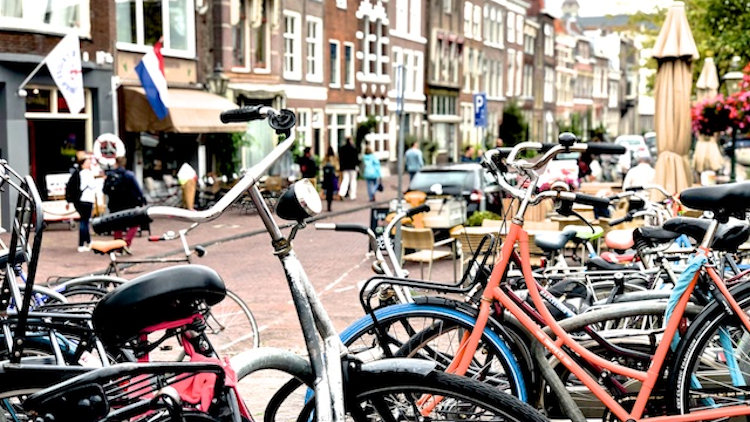

A Walking Tour
Situated midway between Amsterdam and The Hague, Leiden came of age in the seventeenth century when the Netherlands was one of Europe’s most prosperous countries. Well-known because of the University of Leiden, the city became wealthy because of trade, printing and manufacturing.
For our first day we took a walking tour of the city with Marike Hoogduin. She began with a fact many people don’t know. The most famous painter of the Dutch Golden Age, Rembrandt Harmensz van Rijn (1606-1669), was born in Leiden. She offered to show us Leiden as young Rembrandt would have seen it.
Having a walking tour with a knowledgeable guide gives a visitor an up-close and personal experience with a city. Driving in a car may cover more ground, but walking on cobblestone streets and exploring a narrow alleyway leading to a garden or stopping in an ancient coffee shop puts sights and sounds into the experience of discovery.
A native of Leiden and trained as an art historian, Marike was well-qualified to be our guide. As we walked on Lokhorstraat, a street little changed in four centuries, Marike talked about Rembrandt’s early years.
As a boy from 1616-1620, he attended the prestigious Latijnse School (Latin School). In the morning on his way to school he would have passed the Gravensteen prison, an imposing building in Het Gerecht square. There he would have seen shackled prisoners and on some days, as the square filled with a crowd of citizens and officials, condemned prisoners waiting their turn with the executioner.
When we visited the Mauritshuis in The Hague, we saw Rembrandt’s The Anatomy Lesson of Dr. Nicolaes Tulp (1632). In that famous painting, physicians observing a graphic autopsy surround the body of Aris Kindt, a recently executed criminal. The painting is remarkable for its masterful, lifelike details. Seeing how close the Latin School was to Gravensteen prison, when he painted the Anatomy Lesson, we wondered if young Rembrandt remembered the men he had seen executed.
Today, the Gravensteen is no longer a prison. Children play in the square and the small building where the head of the prison used to live, the t’ Suppiershuysinghe, is a sunny, cozy coffee shop serving freshly baked pastries, coffee, tea and sandwiches.
On the side of the building at Gerect 13 across from the Latin School, Marike pointed to inscriptions on the walls. Mathematical equations by two physicists symbolized an argument they had about which way electrons lean. Left, said one. Right, said the other.
On the t’ Suppiershuysinghe coffee shop, taking up almost the entire side of the building, the poem Loss by the poet Adonis (Ali Ahmad Said Esbe) is inscribed in the original Arabic and in an English language translation. A few steps down the street at 30 Houtstraat, she showed us Shakespeare’s Sonnet XXX painted neatly on the side of a two-story building.
Begun in the early 1990s, what became the Muur Gedichten Leiden (Wall Poem Project Leiden) has so far placed 120 quotations in 39 languages on buildings throughout Leiden. The poems are written high on the walls in their original language with translations in Dutch and English. The website lists all one hundred and twenty and suggests walking tours so you can create a path between quotations as you explore the city.
Walking toward the center of town, Marike picked up Rembrandt’s story.
That Rembrandt attended the Latin School tells us his supportive family was well-to-do. From historical records we know that his father owned several properties within the city and a windmill that milled flour. At fourteen, his parents’ support continued after graduation. They enrolled him in the university but he never attended a single class.
We were staying at the st.Pierre, a charming apartment in a private home on Langebrug. As it turned out, we were only half a block from an important landmark in Rembrandt’s development as an artist.
The lovely buildings on the street were largely unchanged from Rembrandt’s time. But Marike pointed out that Langebrug, which means “long bridge,” was once an open canal. Before Leiden became popular as a leisure destination, the city was important in the production of wool textiles.
She asked us to picture young Rembrandt walking along a polluted industrial canal where raw wool was soaked, dyed and bleached. Even though his parents had paid for his enrollment, he abandoned a university career before it began. At fourteen he knew he wanted to be a painter.
He wanted to learn the fundamentals of painting from Jacob van Swanenburg (1571-1638). In a time when there weren’t art supply stores, before he could become a painter, Rembrandt had to learn how to make paint, brushes and canvases. Using the lessons learned from his more than two decades in Italy, van Swanenburg taught Rembrandt the fundamentals of painting.
Today van Swanenburg’s home houses The Young Rembrandt Studio. The main attraction of the Studio is a charming, multiscreen presentation narrated by an actor playing van Swanenburg who tells the story of Rembrandt and his classmates.
With the exception of a short stay in Amsterdam to pursue his studies, Rembrandt lived in Leiden as he developed as an artist. To support himself, he accepted commissions from wealthy patrons and became a teacher himself. But to advance his career, he had to leave Leiden. When he was twenty-six, he moved to Amsterdam where his work brought him fame and fortune.
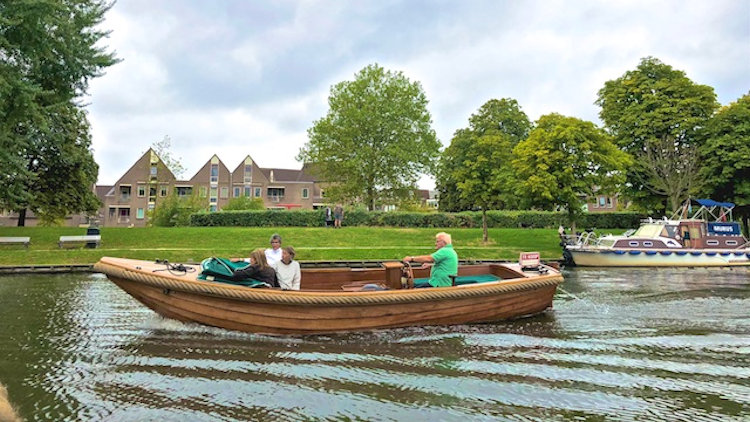

Pilgrims and Almshouses (Hofjes)
Continuing our walking tour, Marike led us down Breestraat (Broadstreet) with shops and the City Hall, across canals with bicycles parked on the bridges, through city neighborhoods with row houses of sturdy brick buildings and down narrow walkways as she told us about the history of Leiden.
We passed the houses where a community of English Calvinists in the beginning of the seventeenth century lived for a decade and prayed at St. Pieterskerk. Escaping persecution, they worked in Leiden’s many industries until by 1620 they had raised enough money to purchase passage to the New World. These were the Pilgrims who sailed on the Mayflower to found the Plymouth Colony. Among those first colonists were Thomas and Anne Blossom from Shelford, Cambridgeshire in England. Amazingly, four U.S. presidents are descendants of the Blossoms, FDR, George H.W. and George W. Bush and Barrack Obama.
Socially conscious, the Dutch believed that those who had the means should relieve the suffering of others. As early as the 15th century a movement began to create almshouses or hofjes, small cottages with courtyards to be used by the poor. Paid for by the wealthy, an almshouse provided a place to live and food to eat. The only cost was the requirement that the inhabitants live good lives and pray.
Leiden has protected this historical legacy. Thirty-five hofjes have survived the centuries. Each hofje was unique, reflecting the interests of its benefactor. Some had chapels. Some were larger than others. Also reflecting the interest of the person who supported the hofje, they were designated for a specific group. Single people, married couples, widows or unmarried women over fifty.
At Doelensteeg 7, we stared up at the inscription carved into the marble slab high above the entrance. Eva van Hoogeveenopened her hofje in 1650. Describing herself as a “chaste virgin,” her cottages were to house only elderly, unmarried women. From the street, the fortress-like building was imposing. But inside, a sunny courtyard was filled with a colorful garden, overgrown with bright pink and white flowering plants. These women’s lives might have seemed bleak, but van Hoogeveen created a refuge for them. Instead of living alone, isolated and lonely, she created a community for women like herself.
Over time, conveniences like indoor plumbing were added. Units were combined to create more spacious apartments. Damaged units were restored and updated.
No longer used to house the poor, the hofjes are prized for their history and the beauty of their gardens. Open to the public, visitors are allowed to walk through as long as they do not make noise or look into people’s homes.
Unique in their design with their distinctive courtyard gardens, the hofjes are hidden treasures. A fun way to explore Leiden is to create a walking tour with the hofjes as anchor points. Available for purchase in the city tourism office, the Leiden Courtyard Tour shows the location of the thirty-five courtyards, has detailed descriptions of the most noteworthy and includes a map with trails between them.
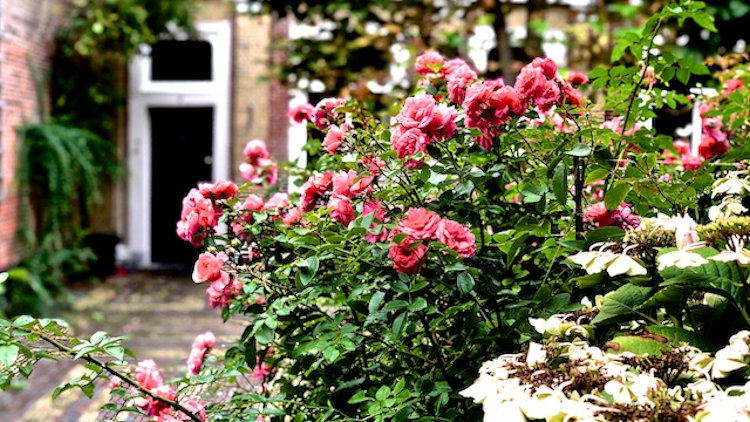

It All Began with a Tulip
After exploring the hofjes’ courtyards, we walked to Leiden University’s Hortus Botanicus (Botanica Gardens). Established in the early 1590s, the botanical gardens are the oldest in the Netherlands.
Created by a man with an unusual name, Carolus Clusius (1526-1609) was born in the Netherlands but spent most of his adult life in Austria, Spain and France. As a horticulturist, Clusius lived in an exciting time. Columbus’ discovery of the New World introduced never-before-seen plants that we now take for granted. Corn, tomatoes, potatoes, tobacco and cacao to name a few.
He researched plants by foraging in the wild and cultivating them in his gardens. Two events changed his life and the history of the Netherlands.
In 1593 he arrived in Leiden to work at the newly founded university. His job was to create a garden that would be used for scientific study. He carried with him a lifetime of drawings and notes about European and New World plants. And, he brought with him a collection of tulip bulbs.
He had written about tulips when he had lived in Spain twenty years earlier but he wasn’t certain they would grow in colder Leiden. Enduring two difficult winters, his tulips survived and thrived. Clusius marveled at the variety of their colors and designs. As a scientist he wanted to know why one tulip had red stripes and another had petals with a yellow fringe. That question would not be answered for over four hundred years. Not until the English horticulturist Dorothy Cayley (1874-1955) discovered in 1928 that a virus not the plant’s genes created the variety of color and design.
Clusius’ tulips were such a sensation that thieves regularly stole his plants and speculators drove up the prices of tulip bulbs to astronomical levels. During the Tulip Mania, fortunes were spent acquiring a single bulb. Even though many suffered financial ruin in 1637 when the trade in tulips collapsed, today the Dutch love of tulips is as strong as ever.
At the entrance we met Carla Teune, one of the garden’s most esteemed horticulturists and, until 2004, the main curator. As we passed through the arched brick entrance, just inside the garden, she pointed out a ragged plant, a laburnum anagyroides (golden rain), poisonous to humans and most animals. Planted in 1601, Clusius and maybe even Rembrandt would walked by the sapling.
Clusius was the garden’s first important horticultural curator but others contributed as well. When Dutch merchants and explorers roamed Europe, Asia and the New World, specimens were sent back for cultivation and study. “We are an old garden with old trees,” Teune told us as we walked past a gnarled, hollowed out Diospyros Lotus (1740), a Japanese Gingko (1785), a two-hundred and fifty-year-old American Swamp Cyprus, a Japanese Elm (1830) and a Weeping Beech (1841).
The botanical gardens celebrate flora that outlive us and ones that live the briefest of spans.
Leaving the giant, ancient trees behind, Teune pointed out flora from China and Japan, the result of work by the German adventurer and scientist Philipp Franz von Siebold (1796-1866). We walked into a grassy area facing the Witte Singel canal. In the Chinese herb garden, we saw lotus plants, their flowers not yet open, their huge leaves a bright green and Szechuan pepper plants topped with bunches of tiny, fierce berries soaking up the sun.
In the bulb garden along the canal bank, my wife, Michelle, stopped to enjoy the brightly colored dahlias in full bloom. Deep red dahlias with spiky petals. Giant orange-red pompons. Dramatic dahlias with black pointed petals and day-glow yellow centers.
Every spring thousands of bulbs and tubers are planted throughout the garden. A mix of wild and cultivated lilies, dahlias, tulips, crocuses, cyclamens and more are planted in borders and raised beds. In 2018, dahlias reigned supreme. In 2019, crocuses will take center stage on the bank of the Witte Singel canal.
Our last stop was the giant Glass House filled with plants that do not like the Dutch winter. Orchids collected in the wild, vanilla plants, giant water lilies five feet across, bromeliads, ferns, cocoa trees, insect eating plants and many others flourished in the warm, damp space.
The gardens are lovely all year round but they come into their own in the warm months when the sky is blue, the flowers bloom and the sun shines brightly on Carolus Clusius’ garden.
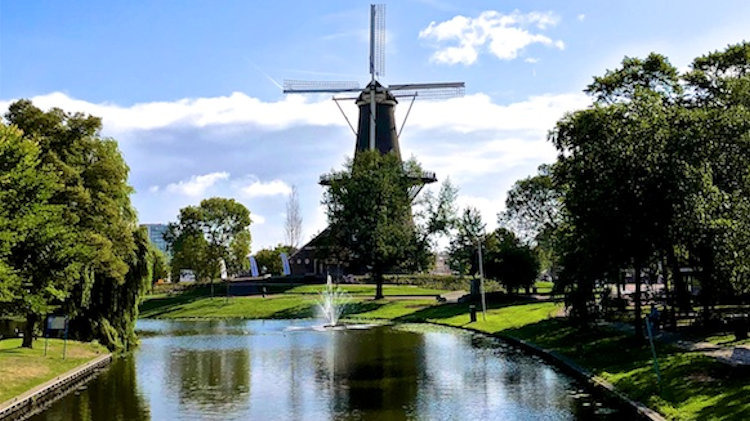

Water, Water Everywhere
In Leiden you are never very far from water. One of our favorite ways to relax was to sit at an outdoor café alongside a canal or east of the city center in De Haven, a small craft marina. We would have a coffee or a meal and do a bit of people-watching as boats of all sizes sailed by.
On Wednesdays and Saturdays, a large open-air market takes over the area around the Nieuwe Rijn (New Rhine). We walked down Botermarket, Vismarkt and Aalmarkt to see what the farmers had brought to market that day. Because we love to cook, on our next visit we’ll definitely do our shopping here. High quality fresh products were for sale at dozens of stands, fresh leafy vegetables, ripe fruit, bright red raspberries and strawberries, farm-fresh cheeses, melons, freshly baked breads and flowers of all kinds and shades of the rainbow.
To see what the city looked like from the water, we arranged for a canal cruise at Bootjes en Broodjes (Boats and Sandwiches). The boats were moored under the Blauwpoortsbrug bridge in the center of town.
Long before paved streets crisscrossed Leiden, canals did the heavy lifting of moving goods across the city. During the Golden Age, locals used the canals as much as the roads to reach their destinations.
Ed was the skipper of our small eco-friendly, electric boat. A college student, he described landmarks as we passed them. Our boat slipped underneath kites shaped like seagulls flying on lines tied to thirty-foot tall poles anchored on the side of the canal. We sailed past windmills, houseboats, boats that had been converted into outdoor cafes and, on the Nieuwe Rijn, the Cathrijn Jacobsdochtershofje, the only hofje on a canal.
We saw places we had been on our walking tour, de Waag where we had lunch and the brightly colored dahlias at the Hortus Botanicus on the banks of the Witte Singel canal.
We ducked when Ed told us too because we were cruising during high tide and the centuries-old, low bridges can be a problem. And, because this was “Bootjes” and “Broodjes,” we opened the large wicker basket and ate delicious sandwiches and drank freshly squeezed fruit juices.
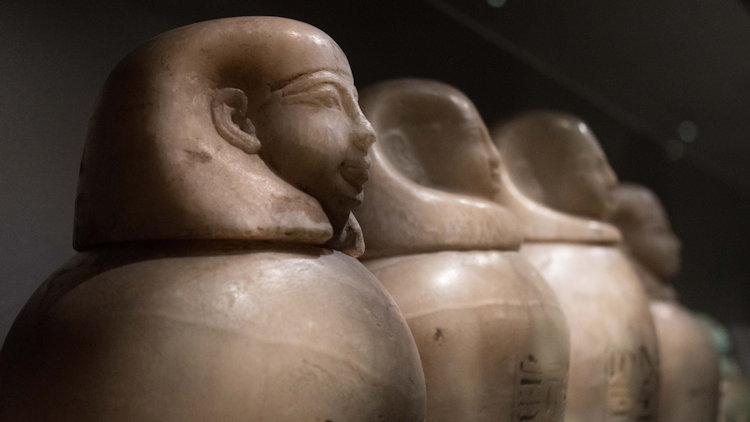

Masters of the Ancient World
After our canal cruise, on our way back to the st.Pierre, our cozy pied-à-terre, we walked alongside the Rapenburg canal and stopped at the Rijksmuseum van Oudheden (the National Museum of Antiquities).
A sister to Amsterdam’s Rijksmuseum, the Museum of Antiquities chronicles the history, culture and art of the ancients. Developed in partnership with the University of Leiden’s archeology department, the museum focuses on Egypt, the Classical Antiquity of the Greeks, Romans and Etruscans, the Ancient world of the Near East and the Netherlands during the periods of prehistory, the Roman occupation and the Middle Ages.
Housed in a former mansion and opened in 1838, the building is beautiful. We walked into a spacious lobby to pick up a map with the floor plan of the museum. We arrived during a dramatic light show imposed on the exterior of an authentic Egyptian temple relocated from the village of Taffeh.
Beginning on the ground floor with the oldest exhibits of Egyptian art, we walked up, floor by floor, moving through time, century after century. Egyptians, Greeks, Romans, Etruscans, Middle Ages. Each object was identified and given a context.
The museum used graphics to illustrate the ways in which civilizations, separated geographically, used trade to interact with one another. Their art reflected that interaction.
Tucked into an alcove on the ground floor, we discovered the work of contemporary artists Bastienne Krame, “Idols XS Paris,” and Camile Smeets, “Poortwachter” (Gatekeeper). Their works showed that borrowing between peoples and cultures continues to this day. Both artists used aesthetics from ancient sculptors to create their inventive, provocative sculptures of women.
In the morning before we took the train to Amsterdam, we walked along the Nieuwe Rijn one last time. The river was glassy and still. A small boat slowly passed by, the woman at the helm sipped a cup of hot coffee to drive away the morning chill. A young couple sat at an outdoor café reading the newspaper. In front of another café, two men arranged chairs at tables, getting ready for the day. From the looks of the sky, the weather would be clear and sunny. We regretted leaving Leiden but we were ready for our next adventure in the Netherlands.
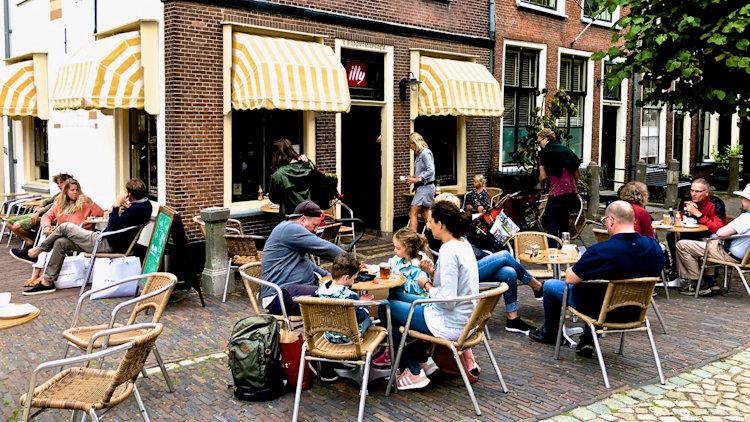

When you go
For information about local destinations, seasonal events, restaurants, museums, music venues, shopping and historic churches, go to Leiden’s official website or, when you are in the city, visit the Tourist Information Office (Stationsweg 26, 2321 AS Leiden. 071 516 60 00, info@vvvleiden.nl). Located close to the Leiden central train station, the tourist office is open seven days a week. Check the website for hours and offerings. The Leiden City Guide in English and Dutch is available at the tourist office and online.
Comprising almost a quarter of the population, students give Leiden an easy-going quality. Many restaurants offer inexpensive, good quality specials of the day (dagschotel) to attract students as well as budget-minded travelers.
Leiden is a good staging point to explore the nearby North Sea resorts and, in the spring, the Keukenhof flower park in Lisse and the Bollenstreek (Tulip Bulb Region).
Bootjes and Broodjes, Blauwpoortsbrug 1, 2312 GA Leiden, +31 (0) 71 514 39 33. One of several companies offering canal cruises in Leiden. Bootjes and Broodjes serves lunch on its cruises, which can be arranged with groups or as a private tour of the city. For details about canal cruises and the private rental of boats, consult the website.
De Markt, Oude and Nieuwe Rijn, 2312 Leiden. Every Wednesday and Saturday, market sellers line the banks of the river offering a mix of goods, including fresh produce, cheese, clothing, books and local crafts. With so much to see, especially at the larger Saturday market, allow time to shop and have a bite to eat at one of the many outdoor cafes.
De Waag, Aalmarkt 21, 2311 EC Leiden, +3171 740 03 00. Originally where merchants weighed their goods, after four centuries the historic building was renovated into a restaurant and bar.
Seating is available inside the large historic building and, in good weather, across the street on a wide patio overlooking the Nieuwe Rijn, with a view of the Hartebrugkerk church which chimes every hour.
Guided Walking Tours. Check the Tourist Office website with details about availability and cost. We can recommend Marike Hoogduin (marikehoogduin@hetnet.nl. 0031 653773808). Fluent in English, friendly and well-versed in art history and Leiden’s past, Marike gave us an excellent tour of the city.
Hofjes. The almshouses are dispersed around the old city. The thirty-one page “Leiden Courtyard Tour” can be purchased at the Tourist Information Office (Stationsweg 26, 2321 AS Leiden). The full color pamphlet in English, Dutch and German has a detailed description of seventeen hofje, a map with the location of all thirty-five almshouses and their courtyards, with suggested walking tours. Originally built inland, the Cathrijn Jacobsdochtershofje (Kaarsenmakerstraat 1, 2312 SG Leiden), was moved to the Nieuwe Rijn in 1928.
Hortus Botanicus, Rapenburg 73, 2311 GJ Leiden, +3171 527 51 44. Check the website for hours, prices of admission and listings for upcoming exhibits. Just past the entrance, the first thing you see when you enter the garden is a recreation of Clusius’ first academic garden with its collection of medicinal plants. Before there were pharmacies, gardens supplied many of the medicines used to cure ailments and diseases.
Italian bar-bistro City Hall, Stadhuisplein 3, 2311 EJ Leiden, +31 71 5144055. Website in Dutch only. Located in the center of the historic city close to the Nieuwe Rijn and inside City Hall, the casual bistro serves large portions of well-made food in a cozy dining room and outside on a large patio.
Latijnse School (Latin School), Lokhorststraat 16, 2311 TA Leiden.
Lot & de Walvis, Haven 1, 2312 MG Leiden, +31 71 7630383. Website in Dutch only. The casual restaurant offers outdoor dining facing the city marina (De Haven) in warm weather and comfortable, indoor dining rooms. The menu is eclectic, borrowing from Dutch and international culinary traditions.
Muur Gedichten Leiden (or Muurgedichten, the Wall Poems Project Leiden). So far, one hundred and twenty poems have been placed on buildings around the city. The project continues to evolve, embracing diversities of language, ethnicity, historical period and, recently, Dutch sign-language. Consult the website and choose your poems, authors or language to create a walking tour.
Rijksmuseum van Oudheden (Dutch National Museum of Antiquities), Rapenburg 28, 2311 EW Leiden, +31 71 516 3136. Check the website for times of admission and descriptions of the permanent collection and temporary exhibits. The Museum café is a must-stop after enjoying the collection. Serving well-made dishes indoors and on the patio with sculptures and a garden, the café is a delight. The mint tea was brewed with fresh mint leaves. The apple tart was fresh and delicious.
st.Pierre, Langebrug 28, 2311 TM Leiden, the Netherlands, welcome@st-pierre.info, +31 (0) 65 10 20 747. Located in the heart of the old city, the apartment at the st.Pierre was perfect for our short stay and would be ideal for a longer term visit because of its full kitchen, access to a washing machine and dryer and an intimate garden patio for meals. The apartment is looked after by friendly co-owner Merjn Mulder. He was a helpful resource for insider suggestions about what to see and what to do in Leiden.
t’ Suppiershuysinghe, Gerecht 2, 2311 TC Leiden, +31 71 513 2829. Website in Dutch only. When the weather is warm, sit outside. The interior has an old-school, eccentric Dutch charm. For a pick-me-up, we stopped twice for their delicious home-made butter cake (boterkoek) and an espresso.
Windmills. One of the best known is the recreated Molen De Valk (2e Binnenvestgracht 1, 2312 BZ Leiden, +31 71 516 5353). Another recreated windmill is within sight of Rembrandtplaats park. The Molen de Put (Park de Put 11, 2312 BR Leiden, +31 6 58927644) is a replica of a windmill built in 1619.
Young Rembrandt Studio, Langebrug 89, 2311 TJ Leiden. In addition to showing a multimedia presentation, the studio sells reproductions

No comments:
Post a Comment